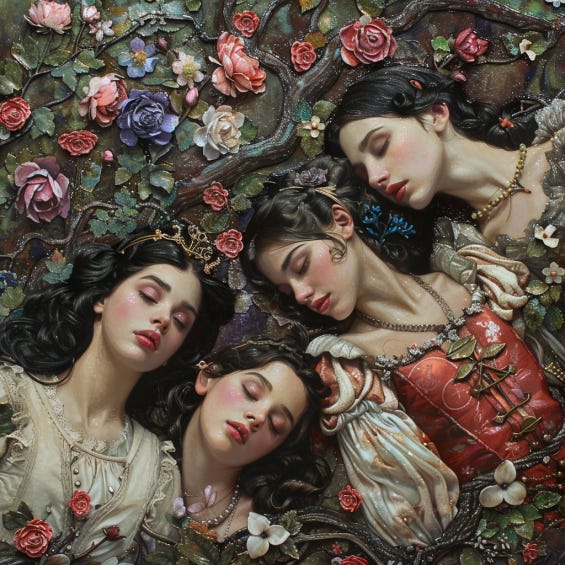The Dark Truth Behind 'The Sleeping Beauty'
& all other fairy tales
Hey everyone! 🌟 Happy morning, and welcome back! We're thrilled to bring you another round of fascinating stories.
But before we dive in, here’s a little challenge to kick off your day:
📌 Today, write a short story—just a few paragraphs—about a day in your life, but with a twist: imagine you’re living your dream life
By imagining your ideal life, you get a clearer picture of what you truly want. It helps to solidify your aspirations and goals, making them more tangible. This exercise encourages you to think creatively about your future. It opens up possibilities and allows you to explore different scenarios, which can lead to new ideas and perspectives.
Now, let’s get started…
The Lesser Known ‘Sleeping Beauty’
The version most of us know, thanks to the Brothers Grimm and Charles Perrault, is a sanitized, romantic tale, but the earliest version by Giambattista Basile, titled "Sun, Moon, and Talia," is anything but a sweet bedtime story.
In Basile's version, the princess, named Talia, falls into a deep, death-like sleep not because of a curse from a wicked fairy, but due to a splinter of flax that gets lodged under her fingernail. Now, here's where things take a grim turn. A king stumbles upon Talia, and instead of trying to wake her with a kiss, he rapes her while she’s unconscious. Yeah, it’s as horrifying as it sounds. Talia remains in her enchanted sleep, but she ends up pregnant and later gives birth to twins, all while still asleep.
But the story doesn’t end there. Talia eventually wakes up, not because of any prince, but because one of her newborns sucks on her finger and accidentally dislodges the splinter.
She wakes up to find herself a mother of two, and if you think that’s the end of the darkness, think again.
The king, who’s already married, brings Talia and the twins into his life, but his queen finds out and, in a fit of jealousy, orders the children to be cooked and served to the king. Luckily, the cook can’t bring himself to do it and serves lamb instead. The queen eventually faces her punishment, and Talia ends up marrying the king.
Cursed ‘Snow White’
Instead of a charming tale about a princess and her happy ending, the Grimm story is filled with eerie and unsettling elements.
For starters, the wicked Queen makes multiple attempts to kill Snow White. She tries to suffocate her with a tight corset, poisons her with a comb, and finally uses a poisoned apple that nearly succeeds in taking Snow White’s life.
But the dark twists don’t stop there. The Queen's fate is especially grim. At Snow White’s wedding, she is punished by being forced to wear red-hot iron shoes and dance until she dies. It's a stark contrast to the happy ending we’re used to.
Moreover, the original story includes some pretty disturbing themes.
For example, the Queen, believing Snow White is dead, demands her liver and lungs as proof of the girl’s death. In a macabre turn, she eats these organs, though they’re actually from an animal, not Snow White.
The Horrors of ‘Little Mermaid’
So, if you think "The Little Mermaid" is just about a girl with a dream of being human and falling in love, there's a lot more to it when you dive into the original tale by Hans Christian Andersen. It's actually pretty intense and not all sunshine and sea breezes.
First off, the mermaid goes through some serious pain. To become human, she has to trade her voice for legs, but these legs aren’t exactly a gift. Every step she takes on land feels like she's walking on sharp knives. Imagine that kind of agony just for a chance at love!
And speaking of love, it’s not all smooth sailing for her. Despite everything she endures—losing her voice and dealing with excruciating pain—the prince she saves doesn’t end up with her. Instead, he marries someone else. Ouch, right? Her heart breaks as she realizes her sacrifices are in vain.
The final blow is both poignant and grim. Instead of a fairy-tale resolution, the mermaid faces an eerie fate. As she’s on the brink of dissolving into sea foam, she is given a chance for redemption. Her spirit is transformed into what’s called a "daughter of the air," which means she’s given the opportunity to earn a soul through good deeds. For the next 300 years, she has to perform acts of kindness to gain this soul and find eternal peace. If she fails in this mission, she will not find rest but will continue to dissolve into the sea foam.
The True Face of ‘The Pied Piper’
The story of "The Pied Piper of Hamelin" is widely known as a German folktale in which a mysterious piper, dressed in multicolored ("pied") clothing, is hired by the town of Hamelin to rid them of a rat infestation. The piper successfully lures the rats away with his magical flute, but when the townspeople refuse to pay him, he retaliates by using his flute to lead the town's children away, never to be seen again.
However, the darker truth behind this tale is steeped in mystery and has inspired various theories over the centuries.
One theory suggests that the story reflects a historical tragedy in the town of Hamelin during the 13th century. Some historians believe that the "children" in the tale may have died from a plague or disease, possibly the Black Death, with the "piper" symbolizing death itself. Another interpretation posits that the children were victims of a tragic accident, such as drowning in the river or being buried in a landslide, rather than being led away by a piper.
Another theory links the tale to the migration of young people, possibly as part of the Children's Crusade. In this movement, thousands of children set out to peacefully convert Muslims in the Holy Land but were instead sold into slavery or died from exhaustion. Alternatively, the children in the story may have been recruited by a landowner to colonize new regions in Eastern Europe, explaining their disappearance from Hamelin.
Some interpretations also suggest that the children were kidnapped, possibly by a pedophile or as part of a human trafficking ring, with the piper representing the person or group responsible for their abduction. This theory introduces an even darker element to the tale, casting the piper as a symbol of danger lurking in plain sight.
BTW, here’s something productive that you can do this weekend. Check this out 👇
In partnership with
Unlock the future of problem-solving with Generative AI!
If you're a professional looking to elevate your strategic insights, enhance decision-making, and redefine problem-solving with cutting-edge technologies, the Consulting in the Age of Gen AI course is your gateway. Perfect for those ready to integrate Generative AI into your work and stay ahead of the curve.
In a world where AI is rapidly transforming industries, businesses need professionals and consultants who can navigate this evolving landscape. This learning experience arms you with the essential skills to leverage Generative AI for improving problem-solving, decision-making, or advising clients, .
Join us and gain firsthand experience in how state-of-the-art technology can elevate your problem-solving skills using GenAI to new heights. This isn’t just learning; it’s your competitive edge in an AI-driven world.
Check out the course here - Consulting in the Age of Gen AI
So, that’s it for today. Let’s meet again tomorrow 👋 Till then, stay curious, and don’t believe every fairy tale!




